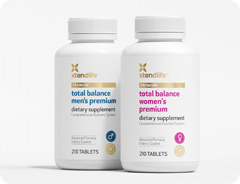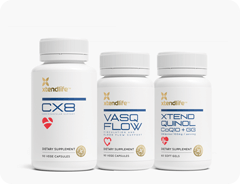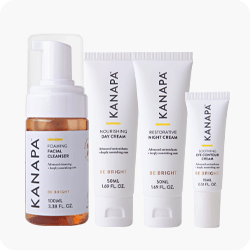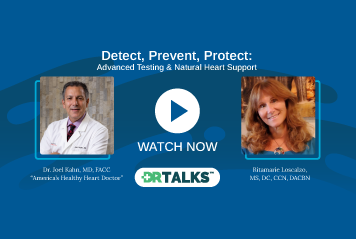At 71, Warren Matthews was healthy, active, and had a clean bill of health - or so he thought. The founder of Xtendlife was blindsided by a build-up of calcification in his cardiovascular system, particularly his aortic valve, which required open-heart surgery. Even with all that Warren was doing to improve his health, he didn't know about the dangers of artery calcification - the invisible threat to heart health.
His hospital wake-up call inspired him to develop CX8, a revolutionary new artery and cardiovascular health supplement. Warren and Ivor Cummins, the Chief Program Officer for Irish Heart Disease Awareness, discuss this groundbreaking natural solution.
In part 1, Warren spoke about his journey from sailing a boat to Asia to lying flat on his back in ICU, caught out by the invisible build-up of calcification in the arteries (watch Part 1 here).
In part 2, Warren spilled the secrets on how he got a heart age of 40 when he was celebrating his 73rd birthday. He also shares the stories and the science that inspired the ingredients in CX8 (watch Part 2 here).
In part 3, he speaks even more candidly about the testing he's had done, the benefits of manufacturing your own products and how he and Xtendlife are continuously improving.
Summary transcript
Ivor Cummins: Hey guys. I've had a huge response to my interviews with Warren Matthews from New Zealand and his formulation to apparently dramatically improve his Pulse Wave Analysis (PWA) results.
There were a few questions put in the comments and we decided we'd do a quick podcast so Warren could address them. It'll be a rapid fire version and we'll go through them all and hopefully yours will get answered.
So great to see you here again, Warren, I know you're busy as usual.
Warren Matthews: Good to be back again, Ivor.
Ivor Cummins: I might just run that short little video clip with my graphs to show the Pulse Wave Analysis results because some people might not have seen the original one.
Warren was 72 and his son Kirk was 42 when they had their first test in January 2020.
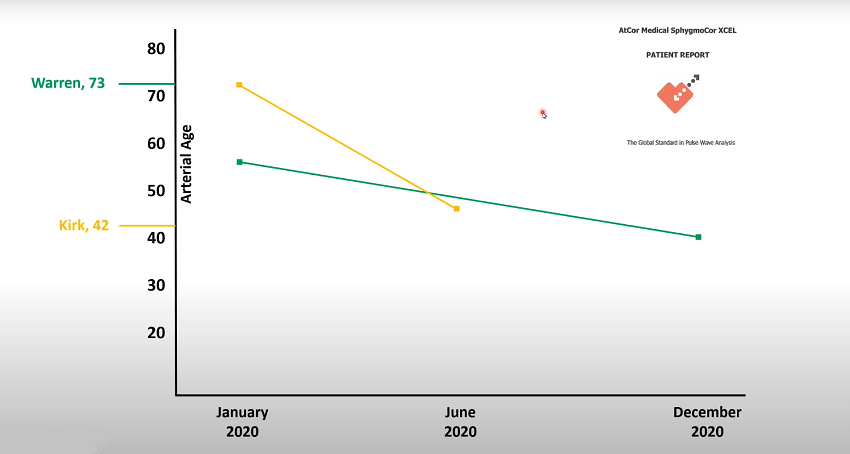
Warren was 72 when he got his first test in January 2020 and his son Kirk was 42 - they got the test concurrently.
So how did Warren do?
Well, he came in at an arterial age of 56!
Now, one would expect when he had massive calcification and his valve had to be replaced he wouldn't be coming in with an arterial age that good, but this was after six months or so of reducing eating; bread and perhaps fewer meals. He had been living healthily for decades - no processed food and junk - but taking an additional step and cutting out bread and carbohydrates would have been important.
And, of course, he was taking the formulation that we'll talk about later in this podcast for over six months.
Kirk, aged 42, came in at an arterial age of 73. Now, Kirk is not overly healthy or has a healthy lifestyle to say the very least, but this was a bit of a wake-up call for him. It was great that he got that result to maybe pay some attention to his health, so he began to take the formulation too and understandably so.
What happened Warren?
He had a 40 year old arterial age, which is remarkable for someone of 73,
especially with a history of severe heart disease.
When he got his next test in December 2020 essentially he'd fallen again and had a very unusual 40 year old arterial age, which is very remarkable for someone of 73, especially with a history of severe heart disease so that was excellent and Warren was obviously very happy.
So how did Kirk do?
He was the one with the wake-up call and six months later in June he got another PWA test. He had been taking the formulation and trying to be better with his lifestyle and diet and he did very well. He was down to an arterial age of 42, which is actually his real age, so a major success given where he was at.
So they're the results from the PWA it's "n equals two", so a very small sample, but I think this will be a fascinating area to look into going forward.
Warren Matthews: Yes, the results which you see there, I have to admit, they were better than what I expected.
I thought I'd have some improvement, maybe a few years, but to go from 56 down to 40 in 11 months! I just hope other people can achieve the same results.
I thought I'd have some sort of improvement, maybe a few years, but to go from 56 down to 40 in 11 months! I just hope other people can achieve the same results.
Ivor Cummins: Well it's "n equals two", but I think it's a great area to look into going forward, and I think you're looking into doing a trial maybe in the future.
Could you give an overview of your calcification readings?
So, one of the first questions was just around your calcification results. I know we talked at length about that, but in the podcast we didn't really touch on it too much. Could you give an overview of your calcification readings?
Warren Matthews: I didn't actually find out about what the Coronary Artery Calcification (CAC) scan was until after I'd had the surgery, unfortunately. There's a video on it here: Why you should get a CAC scan to know your risk for a heart attack or stroke.
It wasn't until I did the research and came across you that I mentioned it to the doctor - they basically knew nothing about it but I insisted I should have one and I said I'd pay for it privately.
So it was agreed I'd do it and when they did it I came up with a score of around about a thousand. Unfortunately, when I had that surgery they put some various clips in there so that distorted the readings somewhat, but the score was just a little over a thousand.
I propose doing another one around the middle of this year, so that would make it about two years since I had it done to see whether it's been improved. I'm not expecting a massive improvement, but as you've pointed out, the important thing is to try and stop the progression of it. I'd be quite happy if it ended up being about the same or slightly less.
Calcification is like scars of battle from the period where you were fighting the inflammatory disease.
Ivor Cummins: The whole thing about calcification, I always tell people, is it's like scars of battle from the period where you were fighting the inflammatory disease.
Some people do actually reverse the calcification a little, it leaches back into the system, and some people steadily keep rolling on upwards, but at a lower rate as the calcification heals and consolidates and gets denser in the old plaque.
So it's a very tricky one. But also if you have clips in there it makes it even more so. I asked Dr Scott Murray, a cardiologist, how much of a score does the stent give and he said, "look it's very hard to say. Once you have stents or clips you get really bright white artefacts and you could easily get several hundred points per stent." So it's just really tricky when there's metal in there because you're looking for tiny spots of calcium in your arteries, but if you've got kind of metal lugs obviously it's going to blow things away a little.
I refused to have stents at all.
Warren Matthews: That's what the radiologist said to me as well. I refused to have stents at all and bearing in mind that the clips were on a single artery because my arteries were basically not too bad except for one which had some buildup of plaque in it.
They normally wouldn't do a bypass on that, but given I was having the valve replaced and the chest opened up they said we might as well do it as long as you can use the vein in the chest. I didn't want everything taken down the leg, but when they put it in they apparently put some metal clips in there and that's what throws the whole system out.
Ivor Cummins: Agree absolutely. No stents, they're very rarely of any great benefit, but again, clips are kind of similar; stents are tiny metal coils so clips might give similar few hundred points each.
The other question was around the Pulse Wave Velocity test. I was familiar with it, but I wasn't familiar with where you can get it. I think it's relatively widely available compared to even calcium scanning which requires a full 64 slice CT machine. So, do you know where you'd get that generally or around the world?
When I started doing some research on the PWA test I found there's a lot of them, in fact it's available just about everywhere around the world.
Warren Matthews: When I started doing some research in it there's a lot of them, in fact it's available just about everywhere around the world, but I suggest that people go into Google and then do a search for it.
Now, there's a link which I've given you which I think maybe we can give to people which they could search for the specific test. I noticed somebody asked where they could get it in Australia, and the particular method was actually developed in Australia, in Sydney.
Anyway, I also did a short video on that subject some time ago, the link is here Heart Attack Prevention: How a Pulse Wave Velocity Check May Help Prevent a Cardiac Event?
Ivor Cummins: Another question was about maltodextrin, and I quickly answered and explained the amounts you're talking about of maltodextrin are tiny and they're only a carrier. But could you explain why the maltodextrin is in there at tiny levels?
Nattokinase has to have a carrier, normally maltodextrin. But the amount is minimal and people can be reassured we do not add maltodextrin; the only excipients are those incorporated within the raw ingredients.
Warren Matthews: We don't add maltodextrin at all, but some of the ingredients use maltodextrin as a carrier. For example, nattokinase. Now nattokinase can't be supplied on its own, it has to have a carrier and the normal carrier that is used is maltodextrin. But the amount used is very minimal and people can be reassured we do not add maltodextrin.
As a matter of fact, in the case of the CX8 the only excipients or other items are actually incorporated within the actual raw ingredients themselves which are necessary to produce them in the first place.
Ivor Cummins: Okie dokie. Soy was also mentioned, and I know a lot of people aren't exactly enamoured with soy, but that's usually in soy foodstuffs and in large quantities. But apparently, soy is listed on the label and that might be because some sub-components may have been derived from soy?
We've made a point over the last few years of removing anything related to soy in our products, but there are some ingredients where part of the active may have been extracted from soy.
Warren Matthews: We've made a point over the last few years of removing anything related to soy in any of our products, but there are always some ingredients that have a component where part of the active may have been extracted from soy in the first place.
In the case of the CX8, ironically enough, I hadn't noticed that the label said it contains soy. It doesn't contain soy as such, and the crazy thing is that we're required to put it on the label if in fact anything was even derived from it in the first place, even though it bears absolutely no resemblance to soy whatsoever.
So although it's on the label, it's nothing to be concerned about at all because as I said, I'm also anti-soy as well.
Ivor Cummins: Yep, very good. The next question was around the cost. That's understandable because it seems like a lot, and I've worked in high volume manufacturing of high-tech components, and I know that the margins in our industry were quite enormous.
CX8 has eight components from eight different suppliers
and the actual margins are pretty tight.
But I also went through this with you way back at the start on the actual cost of the ingredients. I'm interested in that because I've been involved in manufacturing. You've got eight components from eight different suppliers and the actual margins are pretty tight, but maybe you could give people an idea if they go and buy direct the reality of what the costs would look like.
Warren Matthews: I think probably the easiest way to deal with this issue is just to look at just a couple of ingredients.
One which is very easy is DeltaGold® Tocotrienol Complex. It's easy enough to go online and have a look at what is available. All you have to do is take the amount of milligrams that are in a daily dose of the CX8 multiplied by 30 so you know the total number of milligrams in a month's supply, then look at other alternative products that are using the same DeltaGold® Tocotrienols.
Now remember that there are delta tocotrienols and there are tocotrienols, but there's only one delta type of tocotrienols from annatto. I found one yesterday were from a good brand and it would have involved a USD 100 dollars for an equivalent amount of tocotrienols.
Then if you look to try and find the CyanthOx™, the best I could find for that was also around about USD 100 dollars.
So on two ingredients alone, if you bought them individually,
you'd be looking at about two hundred dollars a month.
So just on those two components alone, if you bought them individually, you'd be looking at about two hundred dollars a month.
Ivor Cummins: The other thing is people need to understand is the economy of scale. The reason it seems a hugely lower cost than buying the 8 independently is when you buy the 8 independently all those manufacturers have to bottle, develop, manufacture and ship them all for each component; there's all that extra waste. But if you bring them into a manufacturing outfit like Xtendlife and put them all together, you've only got one set of manufacturing and shipping and all the other infrastructure.
So again, if people haven't been involved in manufacturing in high volume it'll be harder to understand, but that's why it's vastly more cost-efficient to get them in a formulation than to go individually. Of course, people can go individually if they want that's the whole point.
We're fully vertically integrated, we go from the point of manufacture
to the end consumer.
Warren Matthews: I was also going to mention one other aspect which helps is the fact that we're fully vertically integrated in the respect that instead of having a manufacturer having a margin, a distributor having a margin, and a market or retail having a margin, we go from the point of manufacture to the end consumer.
Consequently it's not an aggregate of all those normal margins it's a much more condensed one. What we've done is work out as to what will make it viable for every consumer.
Ivor Cummins: Absolutely. Vertical integration: again, with the high volume, high complexity products I was involved in manufacturing we were utterly vertically integrated - literally buying in just the raw metals and electronic traces and then coming out at the end with a fully finished product. We had a massive supply chain, and we owned the whole lot. Now, we took a vastly bigger profit margin than I know you have on yours, but that's the nature of the market too that we were in.
So CX8, do you take it a one time or spaced out I think you just you just take it at one time pretty much not a big deal?
Warren Matthews: I always do it at one time. I make a point of just having it at about the same time I have breakfast each morning. It doesn't necessarily have to be taken with food, but I find it much more convenient to take most of the supplements at the same time.
I don't mix the magnesium with CX8, simply because the magnesium can offset the efficacy of the Vitamin K2-MK7.
The only thing I don't do is mix the magnesium with the CX8, simply because the magnesium can offset the efficacy of the Vitamin K2-MK7.
Ivor Cummins:Yes, and I know your particular version of marine magnesium is less likely to give you the laxative effect, but either way the magnesium is taken with a big meal always makes more sense for absorption.
Another question we had was around insulin levels and HbA1c is (glycated haemoglobin), there were some queries around how you looked for those?
My insulin levels have always been pretty good. Since I’ve gone to a much more low-carb diet it has significantly improved.
Warren Matthews: Yes, I think I was asked what my insulin levels we like. They have always been pretty good, but the h1 was bordering on the pre-diabetic - it wasn't diabetic but it was getting close, even though the insulin levels were okay. Since I've gone to a much more low-carb type diet I had it done last time and it was significantly improved, so I'm not all concerned in that area now at all, but I put that down to some changes in diet not the supplement.
Ivor Cummins: Funnily enough I had visitors yesterday evening, a good friend of mine who's in his early 60s, and he brought his bloods and yeah his A1c was up nudging, his GGT was up there, and a couple of others. I checked out what he was eating and he was doing okay, but he'd slipped in the last year.
He did point out he's eating a lot of cheese and snacking regularly during the day. I explained that low carb is great and high fat is fine, but if you're getting older and you're not exercising much, cheese is very easy to get a lot of energy density in and not particularly high in protein. So the very high energy density absorbable fat in cheese might be the thing that's pushing you up there and maybe consider dropping some of that cheese and sticking to the meat, fish, eggs and vegetables and do that for a few months and see can you pull that puppy.
How does lumbrokinase, compare to nattokinase?
There's one question here I'm not familiar with, they mentioned lumbrokinase, saying it may be better than nattokinase?
Warren Matthews: Now that's rather interesting that somebody mentioned that because this is an enzyme which I've only just recently become aware of, and as a matter of fact we've already instructed our chief research scientist to look into it.
We're having communications with a Japanese manufacturer of that particular enzyme at the moment. They're claiming the efficacy of it is better than nattokinase and if it turns out that it is better then we will look at replacing the nattokinase with that particular enzyme. But at the moment there's very few manufacturers of it and they are quite difficult to deal with in the respect that they don't want to supply on its own they want to only supply it in a blend.
Our chief research scientist is looking into lumbrokinase versus nattokinase and like all things, if we find something that is better we'll look at it.
So we're looking into that and there is some validity from what I can see so far as it's a very effective enzyme. That's not to say that the nattokinase is not, it has got a long history and is well proven. But it's like all things, if we find something that is better we'll look at it.
Ivor Cummins: In my technology world "continuous improvement" was the phrase we always lived by, so if new components came up that may be advantageous, we used them as part of continuous improvements.
Someone asked if beer was still good for him! Maybe he was asking was it not bad for him and someone replied if it's a good quality craft beer go for it. I tend to say you've got to live too, so everything in moderation maybe works for some things.
Warren Matthews: Yes, because that'd be a sad day if we couldn't have a good beer at the end of the day.
Ivor Cummins: For me, I like a good red wine that's low in sugar, that's my favorite tipple.
Anyway, that's ideal because beer you know can be described as liquid bread. A beer or two is fine, but a lot of my rugby buddies from years ago could knock out 16 pints in the night and that's a different matter!
Another person asked, is it okay for females?
I always tell people in terms of arterial health and heart health, females and males have essentially the same machine. There is a difference with females, that whether through iron depletion from the monthly cycle or hormonal differences, there's an element of protection. Up to menopause, and around seven or eight years after menopause, the risk for heart disease goes to matching men.
So females have a bit of an advantage, but physiologically the system is the exact same for any benefits you can gain from any of these components, so I guess you'd agree with that?
CX8 seemed to appear that it's for males because I'm using it myself, but we've got a lot of female customers using it as well.
Warren Matthews: Absolutely. I think that as far as we're concerned it wasn't developed with a specific gender in mind. It seemed to appear that it's for males because I'm using it myself but we've got a lot of female customers using it as well.
Ivor Cummins: The last question was on Omega-7 someone said there's more in fish than in sea buckthorn. Now I know that's probably true about omega-3, DHA, EPA, but I don't know about Omega-7. Is it particularly high in fish?
If you look at the Omega-7 content in fish, there's actually more in sea buckthorn, but there's even more in the CardiOmegia™ we use than in the normal sea buckthorn because of the way they process it.
Warren Matthews: If you look at the omega-7 content in fish like sardines, there's actually more in sea buckthorn but then on the other hand there's a lot more in the CardiOmegia™ Sea Buckthorn Fruit Extract we use than what there is in the normal sea buckthorn because of the way they process it.
There's a bar graph showing the differences below, more detail is on our CardiaOmegia overview (PDF).

Ivor Cummins: I think that's the list, so we'll probably keep it tight because I know your day is starting, Monday morning, Sunday night here. I'm going to go and get myself either a ribeye or perhaps some lamb chops, but it'll be something deliciously meaty I can assure you that.
Warren Matthews: Well that's good. I think that it was good to be able to cover those points so there was no questions left outstanding, of course if anybody has any more are they easy enough just to either email our customer.services@xtend-life.com or put some comments below.
Ivor Cummins: Great stuff. We'll be back anyway with some other interesting topics in the coming weeks so people can watch out for that and I guess we leave it at that for today thanks a lot Warren.
Product spotlight

CX8 - Cardio Support
Support your heart and address the main causes of cardiovascular problems with the synergistic action of 8 ingredients.
30 Day Supply | 90 Vegetarian Capsules

Omega 3 / QH Premium CoQ10
Boost your energy levels and support your cardiovascular health with omega 3 fatty acids & bioavailable CoQ10 ubiquinol.
30 Day Supply | 60 Soft Gels


 Supplements
Supplements Superfoods
Superfoods Bundles
Bundles